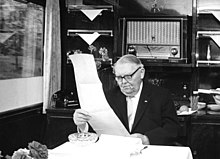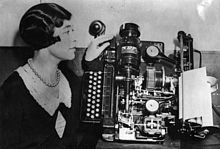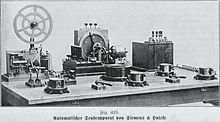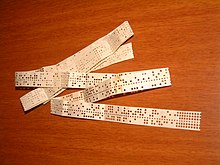Teletype

A teleprinter , also known as a teleprinter or teleprinter , is a telegraph device for the transmission of messages in written form by means of electrical signals. In English the device is called Teletypewriter. (By contrast, Teletype a trademark of the Teletype Corporation are.) Derived from the names RTTY (Radio Teletype writing) for radio teletype and TTY serial interface driver in computers - operating systems .
Morse code devices and the pointer telegraph developed by Siemens & Halske can be regarded as predecessors . Devices related to the teletype are the Hellschreiber and the fax machine .
Input and output
A teleprinter is outwardly similar to a typewriter , with the keyboard , which contains the transmitter unit, and the printer, which houses the receiver, work independently of one another, but are usually operated in series so that what is written on their own page can be read. More modern mechanical and electronic teleprinters also have facilities that signal the recipient when the received character has been sent locally. The recipient then highlights one of the directions in color (e.g. red for the text sent).
The teleprinter equipment often includes a tape reader and tape punch in order to transmit prepared texts using a tape at maximum speed and thus to keep the connection time short or to be able to save text modules. Electronic storage media have also been used since the 1980s .
A distinction is made between chart recorders and tape recorders. Paper writers output the text like a typewriter on an endless roll the width of a normal letter (e.g. DIN A4 ). Strip pens, on the other hand, output the text on a usually 9.5 mm wide paper strip. The telegram service of the Deutsche Bundespost z. B. strip pen used.
Transmission method
Teleprinters use sequential digital asynchronous data transmission with start and stop bits and mostly use a 5-bit code, the International Telegraph Alphabet No. 2 ( CCITT-2, ITA2 or Baudot-Murray Code for short ). This code limits the available character set to 32 characters (2 5 = 32). For the transmission of letters, digits and special characters , the code is divided into two levels, between which you can switch between letters and digits using special characters . Since the two shift characters as well as carriage return and line feed are valid on both levels, the maximum number of characters that can be transmitted is 56, some of which, however, are not used in ITA2. The function was usually checked with the following test sentence, in which every usable character is represented at least once: "the quick brown fox jumps over the lazy dog 1234567890". Since there are no capital letters, the addition of Roman numerals was added, e.g. B. "roem iv" for "IV".
Transmission is usually carried out at 50 baud ; However, there are also devices with a transmission speed of 75 (see picture) and 100 baud. When using a 5-bit code, the character format used consists of 1 start bit, 5 code bits and 1½ stop bits. This enabled a transmission rate of 6.67 characters per second to be achieved in the telex network due to the usual 50 baud. This corresponds to 400 strokes per minute . For experienced writers with the ten-finger system , writing on a mechanical teleprinter may take some getting used to, as the keyboard is mechanically locked when a character is sent and the next key can only be pressed after the last character has been sent. Some mechanical teletyping machines (e.g. Siemens T100s, Lorenz Lo133 automatic) have a mechanical FIFO buffer between the keyboard and the transmitter, which facilitates fluent typing and automatically generates the shift characters for letters and numbers.
The speed of a mechanical teleprinter is usually controlled by a centrifugal governor on the motor, which is usually set with a tuning fork according to the stroboscope principle .
The connection of mechanical teleprinters is done by means of a 40 mA current loop . The logical 1 ("rest position") is represented by the closed loop, the logical 0 ("character position") by the interrupted circuit.
Electronic teletyping machines built later (e.g. HAL DS-3100 ASR ) sometimes have other interfaces such as RS232 , 20 mA current loop or a directly built-in modem .
The phrase “a message runs through the ticker ” is derived from the rhythmic ticking sound of a teletype operator .
Telegraph networks
In 1938, an official telex network was installed in Hamburg by Siemens & Halske. The Deutsche Telekom telex network existed in Germany until 2007 . Telex connections in Germany can still be obtained from Swisstelex . The non-commercial i-Telex network has existed since 2012 and is now the largest telex network in Germany.
armed forces
The armed forces used by the year 1986, the so-called armed forces basic network (GSVBw = Grundschalt- and switching centers of the armed forces) to military communication. It was a meshed star network that worked via control, node and end exchanges and, if one of these components failed, used other communication paths in the network as an alternative (reliability and availability were guaranteed, a conceptual predecessor of the Internet ).
In the 1970s, the Bundeswehr mainly used the telex T100, which was used until the 1990s and was mostly throttled to a speed of 50 baud (to protect materials) . A standard page with 1800 characters thus required almost 5 minutes of transmission time. Abbreviations have been used to save time, such as B. Q and Z codes , which are specified in the ACP 131 regulation. The sending of Bundeswehr telex was still carried out manually until the 1980s: "int zaf rgfsac k" ("Can you connect me to the telex with the rgfsac routing, please come"), "zaf rgfsac" ("I connect with the telex rgfsac ")," de rgfsac qrv k "(" This is the telex rgfsac, we are ready to receive, please come ").
Telex could either be "open" or " VS - only for official use ", "confidential", " secret " or " top secret ". For the latter, encryption devices such as the Lorenz key machine ("Lorenz mixer"), the Elcrotel or the NATO device KW7 had to be used.
In 1986 this network was replaced by the AFDNBw (Automated Telegraph and Data Transmission Network of the German Armed Forces), in which the old teleprinter and key devices could still be used.
As part of the Herkules cooperation agreement - as one of many contractual points - the entire non-military IT of the Bundeswehr was renewed. This led u. a. on the fact that on November 30, 2006 the entire AFDNBw was shut down and replaced by the new MMHSBw (Military Message Handling System of the Bundeswehr).
This system represents, among other things, a simplification of the message traffic, as the employee in a teleprinter no longer has to undergo complex and specialist training. The new system is based on a modified Microsoft Outlook - Client . This corresponds to a large extent to the Microsoft Outlook e-mail program , but has been expanded to include some military specifications. So can u. a. military priority levels (important with regard to the maximum duration of a message from the sender to the recipient) and military degrees of secrecy are entered. In addition, military messages can be encrypted using appropriate plug-ins and also signed using PKI ( Public Key Infrastructure ) cards .
Other networks
In addition to wired teletype networks ( Telex ) there are still numerous radio teletype networks around the world that transmit messages by radio e.g. B. exchange over shortwave . These services are called Radio Teletype , or RTTY for short.
The public telex network of the Deutsche Bundespost and today's Deutsche Telekom operated as an independent network with its own switching centers until the 1990s. The connections for exchanging messages with the telex partners could be established by means of an additional dialing device based on their public telex number, as with a telephone, directly via an automatic dialing device. This network was integrated into the international telex network.
Today there are hardly any pure telex or telex networks and exchanges. Most teletype networks are integrated into further message or data networks via gateways and can in some cases be operated in these systems as an additional service.
Teletypes can also be permanently connected to one another as remote stations in direct operation.
The i-Telex network was launched by collectors. It is thus possible to connect two telex terminals according to the TW39 standard, ED1000 or V.21 using TCP / IP , e.g. B. to connect via the Internet. It is an open network.
Telegraph networks in the GDR

In the GDR several automatic teletype networks existed side by side in self-dialing mode:
- public telex network of Deutsche Post for companies
- BAFESA network of the Deutsche Reichsbahn (BAhn-FErnschreib self-connection system)
- S1 network for authorities and government agencies
and other non-public networks of the NVA , the Ministry of the Interior (MdI) , the Ministry for State Security and the Warsaw Pact .
In line with the importance of a telex connection, it was also possible to use another telex network directly and indirectly by non-network participants.
Further developments
The use of electronics and software means that complex maintenance and adjustments to the mechanical components of a teletype machine and the teletype network are largely eliminated.
The classic mechanical teleprinter has now been replaced in many cases by a telex / e-mail gateway or by a PC with a printer and special hardware for connection to the existing telex connection or for a radio station.
Thus, for the PC software WinTelex32 dial from Swisscom does not own telex line longer necessary. The connection to the telex exchange is made via the public telephone network. WinTelex32 TCP / IP in turn establishes the connection to the telex switch via the public Internet, whereby the normal telex number is retained. The participants are authenticated with X.509 certificates (with 512-bit keys), whereby communication over the Internet is secured with a 128-bit key.
Nevertheless, fax machines , mailbox systems and the Internet practically replaced telex as the main communication method for texts and data at the end of the 1990s.
Advantages of telex
In contrast to Morse code , the message can be read as clear text immediately or later and automatically processed if necessary. In addition, the automatic encryption and decryption of coded telex is also possible using appropriate devices with punched tape.
The message channels used do not have to be constantly monitored manually for incoming messages. In this way, teletype operation can also be largely automated if required and a prepared message can be sent automatically at a specific point in time using a punched tape reader. A high degree of efficiency in the utilization of the message channel can thus be achieved.
The Telegraph is a special modem directly to an existing V.31 be connected interface for data transmission. Automatic measuring stations or telecontrol devices can also be easily connected to an existing telex connection and data and commands can be sent as "telex".
The greatest advantage of telex is still the simple and secure type of automatic text and data transmission over any transmission medium such as radio and data networks as well as alternating current telegraphy over existing telephone lines. Today the teletype service is often carried out over existing data connections using converters or converters as a guest system or through gateways to other networks or by radio.
AC telegraphy
A telex connection required four wires in duplex mode, a telephone connection two wires. With the help of so-called alternating current telegraphy (WT), frequency bands that were not required for voice transmission were cut out of a two-wire telephone connection and used to transmit the teleprinter signals. The first device of this type was the Siemens AC telegraph device FM WT 1 M; later devices were more powerful and could be operated independently and simultaneously by multiple use of an existing telephone channel several speech and telex channels. The frequency modulation of the individual telex and telephone channels is common with this method . The carrier frequencies are modulated with the message content and transmitted together on a line and demodulated again separately at the end. A telephone channel can accommodate up to 24 telex channels with a telegraph speed of up to 50 baud. At higher telegraph speeds, fewer telegraph channels are possible due to the limited bandwidth of the carrier channel.
When the bandwidth of a telephone channel and the telegraphing speed are limited, simultaneous independent operation of both operating modes on a telephone channel with the NVA MWT 1/2 's AC telegraph device is possible.
Gateway systems for telex
The gateway systems for teleprinter e-mail often allow data to be exchanged for pure text messages in both directions. With these systems, for example, each telex connection in the gateway can simply be assigned its own e-mail address. The messages themselves are converted in the gateway as system mail messages and can thus be received by the recipients via mailbox systems or directly over the Internet as e-mail. When receiving an e-mail in text format, the e-mail gateway accepts the text message and converts it into a telex. The addressing and the automatic forwarding ( routing ) to the desired message recipient takes place via certain telex addresses defined by the gateway and with address rules when the message is sent with the teletype or from the remote station. In addition to its own, the gateway's address often also contains the recipient's telex address. Based on this, the direct automatic assignment and routing of the message to several desired telex recipients is automatically possible through the gateway.
Radio telex for sea weather reports
The most well-known application of radio telex in shipping is the sea weather reports, which are still regularly sent to the ship's crews by radio today. This service is also provided by the German Weather Service .
Telex on amateur radio
In amateur radio , decommissioned teleprinters of the usual design and use for the hobby "RTTY" were used (and in some cases still are today). Strip recorders were and are popular because with these devices a loss of the “Line feed” command has no effect on the readability of the message (lines cannot be overwritten). Radio amateurs worldwide use a transmission rate of 45.45 baud (in contrast to professional services with 50/75/100 baud), in which tone frequencies are "keyed" depending on the character polarity ( frequency shift keying ). These frequencies can then be converted to the target frequency (e.g. using SSB ) and transmitted.
Today personal computers are predominantly used for telex traffic, which generate the required audio signals via a modem and the sound card of the computer and evaluate them when received. The programs required for this often also master the fax, HELL and Morse code telegraph modes .
The successor service Teletex
→ Main article: Teletex
At the beginning of the 1980s, attempts were made in the Federal Republic of Germany to introduce the teletex service (not to be confused with teletext as a generalization of teletext) as a more attractive successor to the telex service. In today's practice, e-mail has largely replaced this technology.
Teleprinters and computers
Teleprinters are basically serial digital input and output devices. As a result, they were used to a large extent as computer peripheral devices - on the one hand with their printing part as a pure output device, on the other hand with the keyboard as a terminal for direct control of a computer. Traces of this use can still be found today, for example in the control characters Carriage Return (CR) and Line Feed (LF). At some universities, teleprinters were still in use until the 1970s to create program punch strips and print out the results produced on a strip punch.
When the first microcomputers appeared in the 1970s , there were initially few offers of affordable printers. Instead, many companies or universities had teleprinters that could be connected as printers via suitable interfaces . The data was transferred via the punched tape or via an existing COM interface e.g. B. RS-232 and exchanged with the help of a special connection device. All this also applied to early home computers (before approx. 1980), where teleprinters that were available relatively cheaply were used.
The ASCII code was developed for teleprinters from the 1960s and is still used for computers today.
With Unix-like operating systems, the device files for serial interfaces and pseudo-terminals continue to have the names ttyS * and tty * .
The serial data transmission for telex is also used unchanged to this day (see, among other things, the TTY interface ).
Web links
- Digital data transmission from Odysseus to the present day ( Memento from May 2, 2008 in the Internet Archive )
- DF3OE's virtual telex museum
- Picture of a typical teletype teletype machine
- Broadcast schedule of the German Weather Service
- Functional fax and telex technology in the technikum29 museum
- Image collection of telegraph systems in switching technology with many detailed shots
- Private telex collection, including pictures of the measurement technology required
- 80 years ago: Start of public telex in Germany by (Detlef Borchers) / (jk) on heise.de on October 16, 2013
- T1, T2 e Te 300: tre generazioni di telescriventi Olivetti . Three generations of Olivetti teleprinters (Italian).
Individual evidence
- ↑ Description of the Lo15 telex, mode of operation, page 4f (PDF; 9.6 MB)
- ↑ Description of the telex Lo15, setting the engine speed, page 22 (PDF; 9.6 MB)
- ↑ Lt. Mail from Swisstelex (July 2016) from 35 users, i-Telex according to server as of April 4, 2018 - 105 users, and the trend is rising.
- ↑ Gone eV: GSVBw 22 Elmlohe. Retrieved January 26, 2020 .
- ↑ Dr. Rudolf Hell: Teletype Siemens T100. Retrieved January 26, 2020 .
- ↑ ZDv 50/6 - traffic abbreviations for telecommunication services (Operating Signals) (ACP 131 from July 1953) - German Digital Library. Retrieved January 26, 2020 .
- ↑ Elcrotel 4-S encryption device. In: German Spy Museum. Retrieved January 26, 2020 (German).
- ↑ KW-7. Retrieved January 26, 2020 .
- ^ Mügge, Karl-Albert: Telecommunication technology . S. Mittler and Son, Frankfurt am Main, Berlin 1959.
- ^ DMC RTTY Contest. Retrieved January 26, 2020 .







